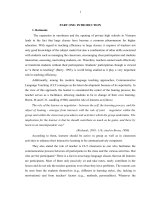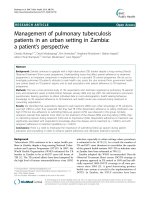Casestudy women participation in beekeeping in Zambia
Bạn đang xem bản rút gọn của tài liệu. Xem và tải ngay bản đầy đủ của tài liệu tại đây (341.4 KB, 4 trang )
WOMEN PARTICIPATION IN BEEKEEPING IN ZAMBIA
THROUGH THE USE OF TECHNOLOGICAL INNOVATION
Author(s): Claire van der Kleij and Malani Simukoko
Country: Zambia
Sector/sub sector/value chain: Agriculture/ Beeproducts
SUMMARY
Beekeeping in Zambia has traditionally been a predominantly male occupation, due
to a mix of cultural and social factors, as well as practical constraints, that limit
women’s participation. A value chain study conducted by SNV in collaboration with
other partners in 2005 revealed that despite its potential for enhancing rural
livelihoods, limited value addition was being realised in prevailing beekeeping
practices. Building on the study findings and comparative experiences in Ethiopia,
SNV saw an opportunity to explore ways of stimulating technological and market
innovations that would also contribute to the goals of encouraging women’s
participation and poverty reduction.
In collaboration with the North-Western Beekeepers Association (NWBKA) and
Mpongwe Beekeepers Enterprise (MPE), the SNV intervention introduced modern
top-bar beehives that can be installed close to the household and are easily
managed by women. Linked to this, SNV facilitated awareness raising on the
importance of enhancing women’s involvement in the sector and supported the two
associations to mobilise women beekeepers to form groups to facilitate access to
credit as well as technical and management support. With funding from Cordaid,
NWBKA and MPE established revolving funds to make the modern beehives
affordable to the women groups.
One of the immediate outcomes of the intervention has been an increase in the
number of women beekeepers, from virtually none to around 450 women
beekeepers at present in North-Western province alone. Based on its experience in
implementing honey supply contracts with both men and women producers MPE
decided to focus on supporting women beekeeping with its input service provision
facility as it is more likely to recoup its investments. Currently, MPE has achieved
33% women participation in its supply chain, of which slightly more than 60% are
organised in producer groups.
The use of top-bar beehives has contributed to higher household incomes not only
due to the higher yields achieved but the higher quality of the honey produced,
which is leading to growing demand in the market and opening up opportunities for
up-scaling this intervention model into areas beyond North-Western and the
Copperbelt Provinces in Zambia.
Nevertheless, the key is to ensure that the technology continues to stay affordable
for the women beekeepers and that adequate capacity development is provided for
the correct management of the modern beehives. These challenges are partly
responsible for the marginal adoption of this technology in the country in
comparison to traditional beehives.
CONTEXT
Beekeeping in Zambia has been predominantly a male occupation. This can be
explained by several factors. Beekeeping is generally considered to be a man’s
occupation, and male beekeepers sometimes even object to women becoming
beekeepers. There are also a number of practical constraints that hinder women
from participating in this economic activity. Firstly, the traditional bark hive requires
physical strength and since climbing is often required for the collection of honey,
beekeeping is not considered suitable for women for modesty reasons. Secondly,
SNV Netherlands Development Organisation
1
Case Studies 2012
harvesting honey from traditional beehives also requests long absences from home,
which competes with women’s domestic chores.
In 2005, SNV in collaboration with other research partners conducted a study of the
honey value chain to identify how SNV could position itself in the development of
this sector. The study revealed that limited value addition was being realised due to
minimal investment in technological and market development initiatives. The study
further found that the low priority given to the sector had also affected the scale of
production and productivity of beekeeping. Based on this study and building on the
experiences in Ethiopia, SNV decided to explore ways to encourage technological
innovation in the honey sector as a means of alleviating rural poverty. It is within this
context that SNV saw an opportunity for women to participate in the honey value
chain by introducing modern top bar hives as an appropriate beekeeping technology
for women as they require less physical activity and can be installed closer to their
homes. As a result, women are now better integrated in the honey value chain and
have started to benefit from this additional income source. At the household level,
men have also welcomed women’s participation in beekeeping as it contributes
towards food security and improved income for the family.
KEY
PARTNERS
SNV
INTERVENTION
The key stakeholders that SNV has partnered with on promoting women beekeeping
in Zambia include Mpongwe Beekeeping Enterprise (MBE), which has been
promoting top bar hive beekeeping since 1997, and the North-Western Bee Keepers
Association (NWBKA). MPE’s approach since 1997 has been to encourage honey
production through modern bee hives because of their export market requires good
quality honey. Modern top bar bee hives produce combs which are easy to process
and do not compromise quality as much as with traditional beehives. SNV has also
collaborated with two other partners to enhance women’s technical and
management skills, namely Cordaid and the Forestry Department of Zambia. In
addition to supporting exposure visits, Cordaid has also played a key role in
providing financial support to both MBE and NWBKA for the purchase of this
modern beehive technology.
SNV’s strategy on social inclusion in beekeeping targets two clients, NWBKA and
MBE. Firstly, SNV conducted training on governance for the NWBKA and MBE which
also introduced the importance of enhancing women’s involvement in the sector.
SNV lobbied for women positions in the structure of the associations and in NWBKA
two women became executive members. This alone, rejuvenated their interest in
being actively engaged in beekeeping regardless of the methodology.
Secondly, SNV carried out a value chain analysis of the bee sector and shared the
findings with sector stakeholders, including the women members of the beekeeping
associations. Based on this research, SNV facilitated awareness raising, together with
NWBKA and MBE, for the association members on the viability of the sector and the
benefits thereof in terms of income margins as compared to other rural activities
such as maize production: return on investments is five times more in comparison.
The women members of the association expressed particular interest in how to
further increase their household incomes through beekeeping, which is how SNV
decided to explore possibilities for them in this market.
SNV Netherlands Development Organisation
2
Case Studies 2012
The third element of the
intervention focused on the
empowerment of women with
appropriate
beekeeping
equipment and supporting the
creation of women groups
within the associations. The
reason
for
encouraging
women to work in groups was
because modern beehives
require intensive monitoring
and management which is
better manageable in a group.
Also the high costs of the
technology (50 US$ per hive in comparison to 2US$ for a traditional beehive) would
be more affordable for a group than an individual.
Finally, this approach was encouraged since the incomes and expenditures made by
the women would be managed as a group. In this way, they are able to hold each
other accountable and generate independent incomes to boost their existing
household income sources. NWBKA in collaboration with the Forestry Department
and SNV facilitated training for women beekeepers in North-Western Province on
group management and modern beekeeping skills.
In order to address the challenge of the high cost of modern beehives, SNV
supported NWBKA and MPE to source additional funding for the intervention. In
2009, the two organisations, together with their producer associations in the
Copper-belt and Central provinces, acquired a grant from Cordaid to support
capacity development for beekeepers.
Cordaid’s support was provided in the form of a capital injection to enable the two
associations to generate their own resources. Using the Cordaid funds, NWBKA and
MPE established revolving funds to make the modern beehives affordable to the
women groups. Each group is provided with a top bar hive and is expected to pay
the loan in honey to the association over a 5-year period. With time, this will free up
funds to enable more women to participate in the intervention.
OUTCOMES
One of the immediate outcomes of the intervention has been an increase in the
number of women beekeepers. There are currently around 450 women beekeepers
in North-Western province who are engaged in beekeeping and generating their
own incomes through women groups.
MPE has honey supply contracts with both men and women producers and in turn
the enterprise provides them with input technology services. From its experience,
MPE has found that women’s groups are consistent in honouring their contractual
obligations and avoid side selling in comparison to individuals, mostly men, who
have a tendency to sell their honey quickly even at a lower price to the competition
for short term gain. It is for this reason that MPE decided to focus on supporting
women beekeeping with its input service provision facility as it is more likely to
recoup its investments. In its business strategy, MPE has formulated an objective to
enhance women participation from 10% to 40%. So far 33% women participation has
been achieved, of which slightly over 60% have established themselves in producer
groups within the value chain. Currently, each group produces about 20 kg of honey
per season.
SNV Netherlands Development Organisation
3
Case Studies 2012
The modern top-bar bee hive generates higher incomes from beekeeping than the
traditional bee hives due to its higher yield. During harvest time the selling price of
comb honey is 0.50 US$ per kg regardless of the quality of honey. Still, the average
gross profit for one modern beehive is higher, 13 US$, in comparison to a profit of 6
US$ for one traditional hive. Furthermore, the technology provides the women with
higher quality honey which is more in demand by the market than the honey from
the traditional hives. Therefore the introduction of this technology to women is
slowly spreading to the men as well.
Most female beekeepers through the women groups now sell their honey when
prices are higher and not in the harvest period when prices are low, so they are able
to re-invest more income in food production. The increased participation of women
in beekeeping through the modern technology has also been appreciated by men
since it results in increased household incomes and has therefore contributed to
improved food security.
LESSONS LEARNED
This intervention shows that integration of women into the beekeeping value chain
has a positive effect on household income and employment. Furthermore, the
relationships established between the women producer groups and the processors’
associations have strengthened the value chain as a whole. The provision of input
technology service through a revolving fund and embedded management skill
trainings by the associations to the women has been the key driver of success of this
model. It has provided the women with the opportunity to access technology in a
more affordable manner and therefore the ability to contribute to economic
development in the beekeeping sector. Furthermore, the use of the top bar beehive
has also been appreciated by men in the beekeeping sector since it contributes to
household requirements such as health and education, while men spend their
incomes on other purposes.
Still, the key challenge is to ensure that the technology continues to stay affordable
for the women beekeepers and that adequate capacity development is provided for
the correct management of the modern beehives. These challenges are partly
responsible for the marginal adoption of this technology in the country in
comparison to traditional beehives.
That being said, the market trends indicate that the demand for the modern top bar
hives is growing driven by rising demand from processors for more and better
quality honey Consequently, the market is driving the possibility of up-scaling this
model into areas beyond North-Western and the Copperbelt Provinces in Zambia.
SNV Netherlands Development Organisation
4
Case Studies 2012









